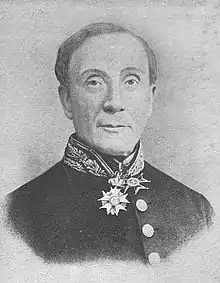Charles-Emmanuel Sédillot
Charles-Emmanuel Sédillot (18 September 1804 – 29 January 1883) was a French military physician and surgeon. He was the son of orientalist Jean Jacques Emmanuel Sédillot (1777–1832), and an older brother to historian Louis-Pierre-Eugène Sédillot.

Charles-Emmanuel Sédillot (1869)
Born in Paris, he studied surgery under Alexis Boyer and Philibert Joseph Roux. In 1836 he became professor of operative surgery at Val-de-Grâce, followed by a professorship at Strasbourg five years later.[1]
Sedillot was a pioneer of urethrotomic and gastrointestinal operations, and known for his work with dislocations and his treatment of pyaemia.[1][2] He is credited with coining the term "microbe" (from micros "small" and bios "life").[3]
Selected writings
- Du nerf pneumo-gastrique et de ses fonctions (1829, doctoral thesis) - The pneumogastric nerve and its functions.
- Phlébite traumatique (1832, thesis for agrégation in surgery) Traumatic phlebitis.
- Campagne de Constantine de 1837 - Constantine Campaign (French North Africa).
- De l'opération de l'empyème, (second edition 1841) - Operation for empyema
- De l'infection purulente, ou, Pyoémie, 1849 - Purulent infection or pyemia.
- Traité de médecine opératoire : bandages et appareils (third edition 1865-66) - Treatise on operative medicine : bandages and devices.
- De l'uréthrotomie interne, 1858 - Internal urethrotomy.
- De l'Évidement sous-périosté des os (second edition 1867) - Subperiosteal recess of the bone.[4]
References
- Google Books System of Surgery by Frederic S. Dennis
- Biographical Dictionary outstanding physicians of the nineteenth century. Berlin, Vienna, 1901, 1567-1569
- Google Books The Phrenological Journal and Science of Health: Incorporated ..., Volumes 92-93
- IDREF.fr (bibliography)
External links
- NCBI A pioneer in medicine and surgery: Charles Sédillot (1804-1883).
This article is issued from Wikipedia. The text is licensed under Creative Commons - Attribution - Sharealike. Additional terms may apply for the media files.